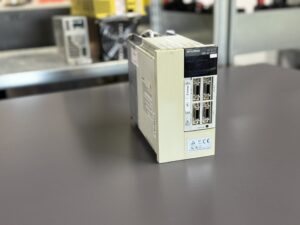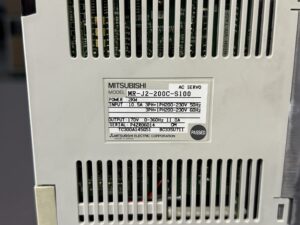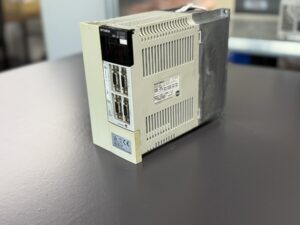10.05.2025 by Viktor Siebert
Defective Servo Drive MR-J2-200C-S100 and a Costly Spare Part Mishap
A true story from our workshop illustrates just how crucial the authenticity of spare parts can be:
One of our customers owned a wire EDM machine (a CNC-controlled system for precision cutting using wire electrical discharge machining) and was facing issues with a defective Mitsubishi MR-J2-200C-S100 servo drive. This component is the core of a drive axis – without a functioning servo amplifier, the entire machine comes to a halt. In a rush, the customer ordered what appeared to be an identical replacement unit from a parts supplier in the UK. But once installed, reality hit hard: the machine immediately displayed error messages, and the axis could not be properly controlled.
It quickly became clear that something was wrong with the replacement device.
Visually, it looked like a genuine MR-J2-200C-S100, but our analysis revealed it was not an original unit. The replacement was merely cosmetically refurbished and falsely labeled – in truth, it was a different model without the S100 option. In other words: a fake unit that lacked key functions. Frustrated, the customer turned to the original machine service provider but received almost no support – it seemed they either couldn’t or wouldn’t help in this case. Eventually, the customer came to us.
After thoroughly inspecting both units, we confirmed the suspicion: the supplied part was not a genuine S100 drive. Instead of trying to make it work, we decided to save the customer’s original unit. Through an express repair, we replaced the faulty components and restored the MR-J2-200C-S100 to working condition. Just three days later, the wire EDM machine was back in operation – fully functional with the repaired original servo drive. This experience clearly highlights how important it is to choose the right spare parts and a technically competent service partner.
Beware of Counterfeit Spare Parts!
This case involving the MR-J2-200C-S100 servo drive illustrates two essential points:
First, the critical role such a component plays within a machine.
Second, the risks associated with counterfeit parts.
In this instance, installing a fake servo drive led to production downtime, troubleshooting confusion, and extra effort and cost.
Imitation or tampered spare parts might seem affordable or readily available at first glance – but they can hide serious flaws: missing features (such as the S100 control option), inferior components, or plain incompatibility with your system.
In the worst-case scenario, they can cause damage to your machine or pose safety risks to operators.
Our recommendation:
Always check the authenticity and origin of spare parts.
When in doubt, consult authorized service providers or the manufacturer – especially for safety-critical components like servo drives.
A reputable supplier will demonstrate technical expertise, provide warranties, and offer support when issues arise.
Look out for original labels, valid serial numbers, and compare technical datasheets – does everything match your original device?
In today’s digital age, it’s easier than ever to verify technical specifications online (as demonstrated in this article).
And in many cases, it’s better to professionally repair a faulty original device than to take risks with unknown sources.
Final thought:
High-quality machine components like the Mitsubishi MR-J2-200C-S100 AC Servo Drive are the backbone of modern automation. Their technology enables precise and reliable processes across numerous industries.
At the same time, their failure requires measured and informed action – quick fixes with dubious spare parts often cause more harm than good.
So choose wisely:
Rely on genuine parts and experienced service partners.
This way, your production stays on track – and costly surprises like the one in our story can be avoided.



More Info & Contact
To mentioned Mitsubishi Drive: Mitsubishi AC Servo Drive MR-J2-200c-S100
More details about our Mitsubishi repair services can be found here:
Mitsubishi drive Repair by Industrypart
We regularly repair similar models, including:
MR-J2-200C
Technical Specifications of the Mitsubishi MR-J2-200C-S100
The MR-J2-200C-S100 is designed for use with AC power supplies ranging from 200 to 230 V and is typically operated in a three-phase configuration. The most important technical specifications are summarized in the following table:
| Technical Feature | Value / Description |
|---|
| Rated Power | 2 kW (2000 W) servo amplifier output |
| Supply Voltage | 200–230 V AC, 50/60 Hz (typically 3-phase) |
| Rated Input Current | Approx. 10.5 A at rated load |
| S100 Option | Integrated 1-axis positioning controller (“Motion Controller”) with internal programming |
| Program Memory | Up to 8 programs, each with a maximum of 60 movement steps |
| Interfaces | RS-232C / RS-485 serial ports (for PC connection or networking up to 32 axes) |
| Digital I/Os | Approx. 12 digital inputs (24 V) and 6 transistor outputs for control signals (e.g. Start, Ready) (typical for S100) |
| Compatible Motors | Mitsubishi MELSERVO-J2 servo motors (power range 0.05–3.5 kW), with absolute encoder (131072 pulses/rev) |
| Special Features | Absolute positioning mode (no homing needed), automatic gain tuning, anti-vibration control in standstill, multiple control modes (position, speed, torque), extensive protection functions (overcurrent, overheating, overvoltage, etc.) |
Common Alarm Codes and Troubleshooting – MR-J2-200C-S100
| Alarm Code | Error Description | Possible Causes | Recommended Actions |
|---|
| A.10 | Undervoltage | – Input voltage below 160 V- Power cycled too quickly- Disconnection at CN1A, CN1B, or CN3 | – Check and stabilize input voltage- Wait at least 5 seconds before restarting- Check all cable connections |
| A.16 | Encoder Error 1 | – Encoder not connected- Faulty encoder- Broken or shorted cable- Incompatible motor-drive combination | – Check encoder cable- Replace encoder if necessary- Ensure motor and drive are properly matched |
| A.20 | Encoder Error 2 | – Communication error with encoder- Damaged encoder cable- Excessive acceleration causing oscillation | – Inspect/replace cable- Adjust acceleration parameters- Reduce auto-tuning gain settings if needed |
| A.24 | Main Power Circuit Error | – Ground fault at U/V/W output- Insulation failure in motor cable- Faulty main power circuit in amplifier | – Perform insulation test- Replace motor cable- Test or replace the amplifier |
| A.25 | Absolute Encoder Data Error | – Battery depleted or faulty- Wiring issue with battery- Supercapacitor not charged | – Replace battery- Verify wiring- Perform reference return after battery change |
| A.30 | Regenerative Circuit Error | – Brake resistor overloaded- Regeneration transistor faulty- Cooling issue | – Check brake resistor and transistor- Improve cooling- Verify brake resistor settings in parameters |
| A.31 | Overspeed | – Excessive pulse frequency- Acceleration/deceleration times too short- Servo system instability | – Limit pulse frequency- Increase accel/decel times- Re-tune system or run auto-tuning |
| A.32 | Overcurrent | – Short circuit at U/V/W output- IPM failure- Ground fault- External surge or noise | – Check and correct wiring- Replace amplifier if needed- Improve EMI shielding and grounding |
| A.33 | Overvoltage | – DC bus voltage > 400 V- Faulty brake resistor- Unstable power supply | – Check power input- Inspect and replace brake resistor- Use higher-capacity brake resistor if needed |
| A.37 | Parameter Error | – Incorrect parameter or point data- Internal memory error | – Verify parameter and point data settings- Reset amplifier to defaults or replace unit if error persists |
| A.46 | Motor Overheat | – Ambient temperature > 40 °C- Motor continuously overloaded- Temperature sensor in encoder faulty | – Improve cooling conditions- Analyze and reduce load- Replace motor or encoder if necessary |
| A.50 | Overload 1 | – Long-term mechanical overload- Aggressive control parameters- Mechanical friction or stiffness issues | – Check mechanical load- Re-tune servo gain- Use auto-tuning |
| A.51 | Overload 2 | – Mechanical blockage or collision- Asymmetric load- Faulty wiring | – Inspect machine for blocked axes- Correct wiring- Re-check servo setup and mechanical clearances |